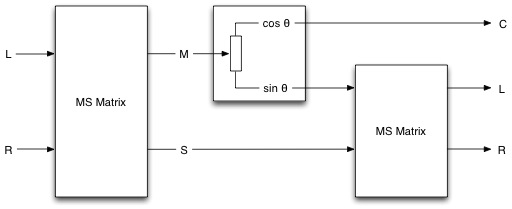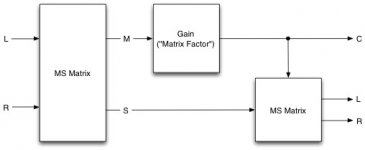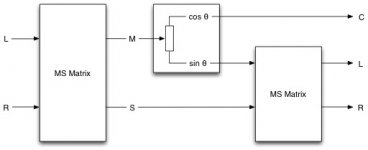No . . . the comment was more sarcastic than serious. MS matrixing only works when capsule/"driver" spacing is a fraction of a wavelength.
That's why it works well with most recordings
What's the next step for the experiment? A FRS8 at center too or will you try e.g the Nathan there and see if the tonality is a problem?
I really like nearfield bass. Not having to worry so much about neighbors is relaxing, and I also think that the lower overall bass in the room makes things sound better (less boomy) from another room. Do you add a delay or not worry about it?
I really like nearfield bass. Not having to worry so much about neighbors is relaxing, and I also think that the lower overall bass in the room makes things sound better (less boomy) from another room. Do you add a delay or not worry about it?
Yes, those are FRS8's but I got it to "work" with Behringer P2031A's and B200's too. Very different speaker concepts. They simply differed in tonality but not in spatial properties. The important part is level, timing and spectrum of the reflections.
The near field subs are crossed in at 150Hz for the FRS8's.
What's the next step for the experiment? A FRS8 at center too or will you try e.g the Nathan there and see if the tonality is a problem?
I really like nearfield bass. Not having to worry so much about neighbors is relaxing, and I also think that the lower overall bass in the room makes things sound better (less boomy) from another room. Do you add a delay or not worry about it?
Adding a FRS8 center is next. It's already in use for surround playback.
I'm currently revisiting Gerzon's Trifield paper from 1991 ("Optimal Reproduction Matrices for Multispeaker Stereo").
Near field bass is fantastic. A high cut-off adds envelopment. Stereo bass finally might make sense in a small room. Needs to be tested though.
To answer your question, yes I did add delay to the subs.
Last edited:
I'm currently revisiting Gerzon's Trifield paper from 1991 ("Optimal Reproduction Matrices for Multispeaker Stereo").
Why not simple passive matrix with coefficient 0.5 for starters ?
Gerzon had so many theories it will take a life time to try them all..
- Elias
Also please try the side wall setup I've shown. There's something "special" about this.
I've had my Nathan's set up in a standard ±30° stereo triangle away from the walls, with a 45° toe-in. The loud contralateral reflection had a detrimental effect on imaging. With the speakers directly at the wall, the problem is completely gone. The resulting reflection pattern seems to aid reproduction (spaciousness and depth).
The contralateral reflection is indeed a detrimental one in my experience. Perhaps such a wide setup compensates for the reduced channel separation with a summed centre?
Anyway, I need to build me an extra speaker first
Why not simple passive matrix with coefficient 0.5 for starters ?
Gerzon had so many theories it will take a life time to try them all..
- Elias
Wrote a little script for Reaper. The matrix factor can be varied with a slider:
Code:
//=================================================
desc: 2to3
slider1:0.5<-0,1,0.05>Matrix Factor (0-1)
//=================================================
@slider
matrix_factor = slider1;
//=================================================
@sample
l_in = spl0; r_in = spl1;
//create MS from Left/Right
m = 0.7071*(l_in+r_in);
s = 0.7071*(l_in-r_in);
//Re-matrix to Left/Right
l_out = 0.7071*((m*matrix_factor)+s);
r_out = 0.7071*((m*matrix_factor)-s);
//output
spl0=l_out; // Left
spl1=r_out; // Right
spl2=m*matrix_factor; // Center
//=================================================Here's the schematic:
Attachments
Reaper code for "Optimum Linear-Matrix" based on Miles:
Code:
//=================================================
desc: 2to3 //based on Miles http://milestech.com/aesimpre.htm
slider1:0.5<-0,1,0.05>Matrix Factor (0-1)
//=================================================
@slider
matrix_factor = slider1;
//=================================================
@sample
l_in = spl0; r_in = spl1;
//Optimum Linear-Matrix
l_out = l_in-(matrix_factor*r_in);
c_out = (1-matrix_factor)*(l_in+r_in);
r_out = r_in-(matrix_factor*l_in);
//output
spl0=l_out; // Left
spl1=r_out; // Right
spl2=c_out; // Center
//=================================================Anyway, I need to build me an extra speaker first
More people shoud do that, really
Thinking about it, it does not make much sense to me to try to reproduce images in the center with speakers placed only at the side ! The whole concept of two speaker stereo is based on compromised technology some 80 years ago. Even more incomprehensible is people accept it just like that without questioning
- Elias
The matrix factor can be varied with a slider:
Have you though about dividing freq bands in Gerzonic manner, as he seemed to emphasise the importance of different hearing mechanisms along freq bands that should be taken into account in the matrix ?
Have you though about dividing freq bands in Gerzonic manner, as he seemed to emphasise the importance of different hearing mechanisms along freq bands that should be taken into account in the matrix ?
Not yet. Currently listening to the "basic" versions.
Interesting observation: the center doesn't seem to be particularly stable with head movements. The stability of phantom sources don't seem to benefit from an additional speaker. Phantom sources created by only two speakers (L-C and C-R) is probably preferable.
Interesting observation: the center doesn't seem to be particularly stable with head movements. The stability of phantom sources don't seem to benefit from an additional speaker.
What coefficients have you tried ? Sounds like totally opposite to my findings.
What coefficients have you tried ? Sounds like totally opposite to my findings.
Well, phantom center sources don't "snap" to the left or the right speaker when moving like they do with normal 2-speaker stereo. But the upmixed center speaker creates a considerable amount of ambiguity when moving.
Well, phantom center sources don't "snap" to the left or the right speaker when moving like they do with normal 2-speaker stereo. But the upmixed center speaker creates a considerable amount of ambiguity when moving.
You should try coefficient of 0.5. It maximises the separation between speakers. Did I suggest it already ?
If you are after the "snap" effect, that is the image locked into the speaker, then you will need much more directional speakers than FRS8.
On the other hand I find the "snap effect" one of the worst features (symptoms) of conventional 2 speaker stereo. It ruins the the rest of the little realism that would possibly have been there in ideal conditions
- Elias
You should try coefficient of 0.5. It maximises the separation between speakers. Did I suggest it already ?
0.5 is the default in my script...
If you are after the "snap" effect, that is the image locked into the speaker, then you will need much more directional speakers than FRS8.
On the other hand I find the "snap effect" one of the worst features (symptoms) of conventional 2 speaker stereo. It ruins the the rest of the little realism that would possibly have been there in ideal conditions
- Elias
I'm not after the "snap" effect. But in my current configuration it sounds more natural despite the spatial distortion. Pick your poison.
You know that Gerzon's techniques are based on assumptions that not everyone agrees with. See papers by Theile.
Last edited:
You might also try placing the 3 speakers in line instead of arch.
In my FDTD simulations it produces better wavefront for both center and off-center listeners:
Elias Pekonen Home Page - FDTD simulations of stereo speaker configurations in small room
- Elias
In my FDTD simulations it produces better wavefront for both center and off-center listeners:
Elias Pekonen Home Page - FDTD simulations of stereo speaker configurations in small room
An externally hosted image should be here but it was not working when we last tested it.
An externally hosted image should be here but it was not working when we last tested it.
- Elias
Yes I did try speakers at the side walls many years ago. All the sound was at the side and nothing much at the center. So it was not good at all. It was about the same time I understood there must be a speaker at the center to be able to generate stable center images. It also eventually lead me to my single speaker stereo SSS concept.
- Elias
- Elias
Yes I did try speakers at the side walls many years ago. All the sound was at the side and nothing much at the center. So it was not good at all.
You have to get the toe-in right then "everything falls into place". Of course this is just a one seat solution but it works remarkably well.
You might also try placing the 3 speakers in line instead of arch.
Gerzon states in his 1991 AES convention paper #3180 that "loudspeakers [that] lie along a straight line [...] generally give
Here's my implementation of a energy-preserving 3x2 matrix decoder:
I'm not sure if the mid signal for the center (after energy preservation) needs to be attenuated by 3dB or not. Anybody?
Schematic:

Code:
//=================================================
desc: Energy-preserving 3x2 Matrix Decoder //based on Gerzon
slider1:35.26<-0,90,0.01>Angle parameter (0-90)
//=================================================
@slider
angle = slider1*0.017453;
//=================================================
@sample
l_in = spl0; r_in = spl1;
//create MS from Left/Right
m = 0.7071*(l_in+r_in);
s = 0.7071*(l_in-r_in);
//Energy Preservation
m_c = m*cos(angle);
m_lr = m*sin(angle);
//Re-matrix to Left/Right
l_out = 0.7071*(m_lr+s);
r_out = 0.7071*(m_lr-s);
c_out = 0.7071*m_c;
//output
spl0=l_out; // Left
spl1=r_out; // Right
spl2=c_out; // Center
//=================================================I'm not sure if the mid signal for the center (after energy preservation) needs to be attenuated by 3dB or not. Anybody?
Schematic:
Attachments
Last edited:
- Status
- This old topic is closed. If you want to reopen this topic, contact a moderator using the "Report Post" button.
- Home
- Loudspeakers
- Multi-Way
- Trinaural decoding equations for 3 speaker stereo matrix ?

